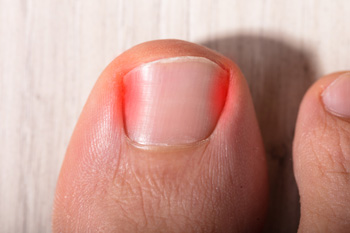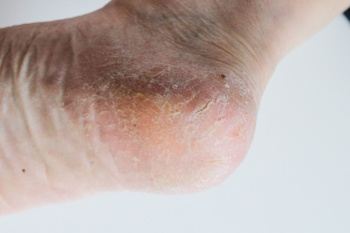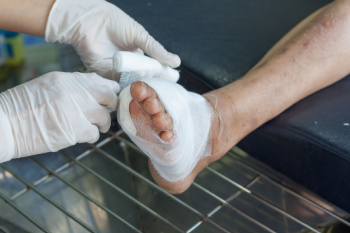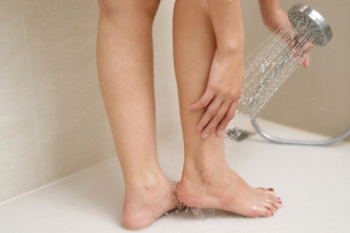Connect With Us
Blog
Causes of Ingrown Toenails

Ingrown toenails develop when the edge of a toenail grows into the surrounding skin, leading to pain, redness, and swelling. This condition can affect people of all ages, from children to older adults. It often involves the big toe and can result from trimming the nails too short, rounding the edges, or wearing shoes that lack adequate support and crowd the toes. Repeated pressure from sports or activities that stress the toes may also cause the nail to grow incorrectly. Some people are born with curved or wide nails that naturally turn inward, increasing the likelihood of ingrowth. If left untreated, the area can become infected and make walking uncomfortable. A podiatrist can remove the portion of the nail pressing into the skin, correct the nail shape, and provide guidance to prevent future issues. If you have developed an ingrown toenail, it is suggested that you schedule an appointment with a podiatrist for a diagnosis and suggested treatment.
Ingrown toenails may initially present themselves as a minor discomfort, but they may progress into an infection in the skin without proper treatment. For more information about ingrown toenails, contact one of our podiatrists of Foot & Ankle Associates of Maine. Our doctors can provide the care you need to keep you pain-free and on your feet.
Ingrown Toenails
Ingrown toenails are caused when the corner or side of a toenail grows into the soft flesh surrounding it. They often result in redness, swelling, pain, and in some cases, infection. This condition typically affects the big toe and may recur if it is not treated properly.
Causes
- Improper toenail trimming
- Genetics
- Improper shoe fitting
- Injury from pedicures or nail picking
- Abnormal gait
- Poor hygiene
You are more likely to develop an ingrown toenail if you are obese, have diabetes, arthritis, or have any fungal infection in your nails. Additionally, people who have foot or toe deformities are at a higher risk of developing an ingrown toenail.
Symptoms
Some symptoms of ingrown toenails are redness, swelling, and pain. In rare cases, there may be a yellowish drainage coming from the nail.
Treatment
Ignoring an ingrown toenail can have serious complications. Infections of the nail border can progress to a deeper soft-tissue infection, which can then turn into a bone infection. You should always speak with your podiatrist if you suspect you have an ingrown toenail, especially if you have diabetes or poor circulation.
If you have any questions, please feel free to contact our office located in Brunswick, ME . We offer the newest diagnostic and treatment technologies for all your foot care needs.
Cracked Heels and How to Restore Smooth Skin

Cracked heels are splits in the thick skin on the heel that develop when the skin becomes dry, hard, or endures too much pressure. They can be painful and may worsen if not cared for properly. Causes include cold weather, long periods of standing on hard surfaces, wearing open back shoes, vitamin deficiencies, and conditions such as hypothyroidism that affect skin health. These cracks can deepen over time, making walking uncomfortable and increasing the risk of infection. A podiatrist can remove thickened skin safely, recommend moisturizing treatments, and identify any underlying conditions contributing to the problem. If your heels feel dry, painful, or cracked, it is suggested that you consult a podiatrist who can effectively treat this condition, which may include prescribed medication.
Cracked heels are unsightly and can cause further damage to your shoes and feet. If you have any concerns, contact one of our podiatrists from Foot & Ankle Associates of Maine. Our doctors can provide the care you need to keep you pain-free and on your feet.
Cracked Heels
Cracked heels appear unappealing and can make it harder for you walk around in sandals. Aside from looking unpleasant, cracked heels can also tear stockings, socks, and wear out your shoes. There are several methods to help restore a cracked heel and prevent further damage.
How Do You Get Them?
Dry skin is the number one culprit in creating cracked heels. Many athletes, walkers, joggers, and even swimmers suffer from cracked heels. Age and skin oil production play a role to getting cracked heels as well.
Promote Healing
Over the counter medicines can help, especially for those that need instant relief or who suffer from chronic dry feet.
Wear Socks – Wearing socks with medicated creams helps lock in moisture.
Moisturizers – Applying both day and night will help alleviate dryness which causes cracking.
Pumice Stones – These exfoliate and remove dead skin, which allows for smoother moisturizer application and better absorption into the skin.
Change in Diet
Eating healthy with a well-balanced diet will give the skin a fresh and radiant look. Your body responds to the kinds of food you ingest. Omega-3 fatty acids and zinc supplements can also revitalize skin tissue.
Most importantly, seek professional help if unsure how to proceed in treating cracked heels. A podiatrist will help you with any questions or information needed.
If you have any questions, please feel free to contact our office located in Brunswick, ME . We offer the newest diagnostic and treatment technologies for all your foot care needs.
How Type Two Diabetes Can Change the Skin on Your Feet

Type two diabetes can influence the health of the skin on the feet in ways that often develop slowly, but deserve early attention. Higher blood sugar levels may lead to dryness, cracking, slow healing, and a greater chance of infection. Some individuals notice dark, velvety patches, redness, or persistent itching related to circulation concerns or nerve changes. Others experience thickened skin on pressure points or recurring fungal infections that do not clear easily. These changes may signal that the skin is becoming less able to protect the feet and maintain normal healing. Addressing these issues promptly supports comfort and long-term foot health. If your feet are dry, have unusual discoloration, sores that do not heal, or repeated infections on your feet, it is suggested that you see a podiatrist for expert guidance and management tips.
Wound care is an important part in dealing with diabetes. If you have diabetes and a foot wound or would like more information about wound care for diabetics, consult with one of our podiatrists from Foot & Ankle Associates of Maine. Our doctors will assess your condition and provide you with quality foot and ankle treatment.
What Is Wound Care?
Wound care is the practice of taking proper care of a wound. This can range from the smallest to the largest of wounds. While everyone can benefit from proper wound care, it is much more important for diabetics. Diabetics often suffer from poor blood circulation which causes wounds to heal much slower than they would in a non-diabetic.
What Is the Importance of Wound Care?
While it may not seem apparent with small ulcers on the foot, for diabetics, any size ulcer can become infected. Diabetics often also suffer from neuropathy, or nerve loss. This means they might not even feel when they have an ulcer on their foot. If the wound becomes severely infected, amputation may be necessary. Therefore, it is of the upmost importance to properly care for any and all foot wounds.
How to Care for Wounds
The best way to care for foot wounds is to prevent them. For diabetics, this means daily inspections of the feet for any signs of abnormalities or ulcers. It is also recommended to see a podiatrist several times a year for a foot inspection. If you do have an ulcer, run the wound under water to clear dirt from the wound; then apply antibiotic ointment to the wound and cover with a bandage. Bandages should be changed daily and keeping pressure off the wound is smart. It is advised to see a podiatrist, who can keep an eye on it.
If you have any questions please contact our office located in Brunswick, ME . We offer the newest diagnostic and treatment technologies for all your foot and ankle needs.
Simple Footcare Habits That Make a Big Difference

Regular foot care helps keep you moving comfortably and prevents small issues from becoming painful problems. Clean your feet daily with warm water, then dry them well, especially between the toes, where moisture can linger. A gentle moisturizer keeps the skin soft, but avoid applying it between the toes to prevent irritation. Keeping toenails trimmed straight across helps reduce the chance of ingrown nails. Choosing shoes that fit well and offer good support protects your arches and reduces pressure points during daily activities. Inspecting your feet regularly allows you to notice changes early. Look for redness, swelling, thickened nails, or areas that feel tender. These small checks are especially important if you have diabetes or circulation concerns. When something feels off, early guidance can prevent long-term complications. If you notice persistent foot pain, skin changes, or have difficulty walking, it is suggested that you see a podiatrist for an evaluation and appropriate treatment.
Everyday foot care is very important to prevent infection and other foot ailments. If you need your feet checked, contact one of our podiatrists from Foot & Ankle Associates of Maine. Our doctors can provide the care you need to keep you pain-free and on your feet.
Everyday Foot Care
Often, people take care of their bodies, face and hair more so than they do for their feet. But the feet are a very important aspect of our bodies, and one that we should pay more attention to. Without our feet, we would not be able to perform most daily tasks.
It is best to check your feet regularly to make sure there are no new bruises or cuts that you may not have noticed before. For dry feet, moisturizer can easily be a remedy and can be applied as often as necessary to the affected areas. Wearing shoes that fit well can also help you maintain good foot health, as well as making it easier to walk and do daily activities without the stress or pain of ill-fitting shoes, high heels, or even flip flops. Wearing clean socks with closed shoes is important to ensure that sweat and bacteria do not accumulate within the shoe. Clean socks help to prevent Athlete’s foot, fungi problems, bad odors, and can absorb sweat.
If you have any questions, please feel free to contact our office located in Brunswick, ME . We offer the newest diagnostic and treatment technologies for all your foot care needs.
